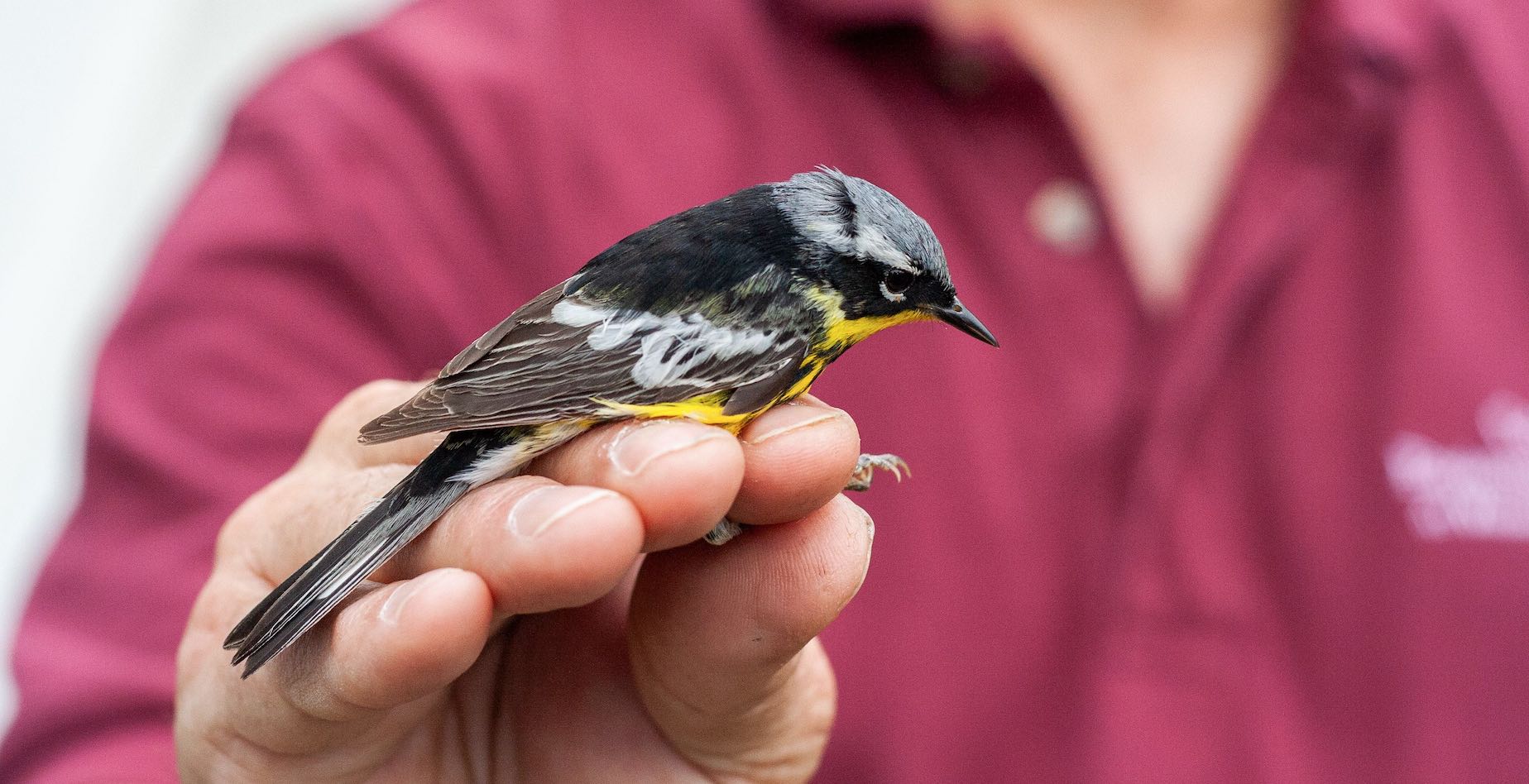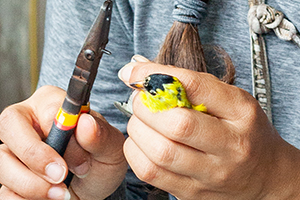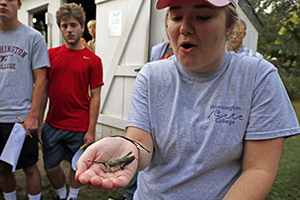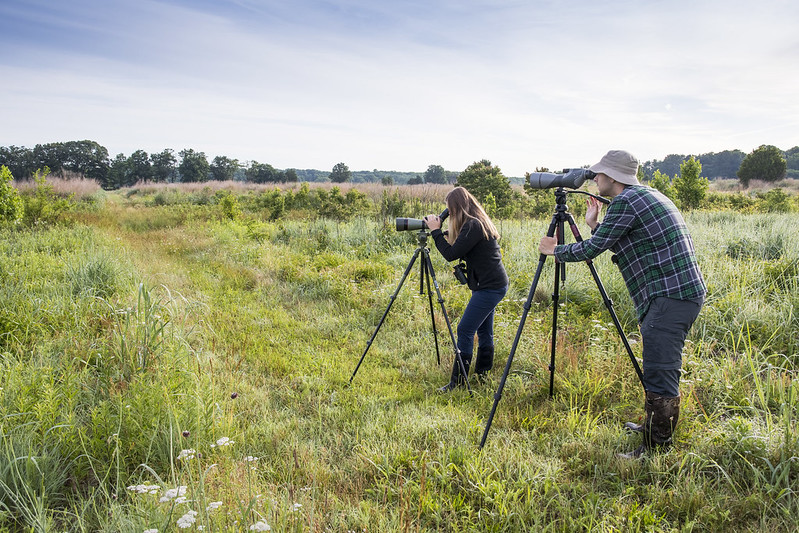
Foreman’s Branch Bird Observatory
We are the only major migratory bird banding station operating on the eastern shore of Maryland. Located on the upper eastern shore 3 miles northeast of Chestertown, MD, we are in a rural area. The habitats at the station include fallow fields, hedgerows, early successional shrub/scrub, second-growth woodlands, mature wood lots and the open water and mud flats of Foreman's Branch.
What's in a name?
FBBO took its name from the local branch of water that runs into the Chester River. Foreman's Branch flows parallel to the banding area and its source is located approximately 5 miles to the south. Its waters provide refuge to thousands of migrating and wintering ducks and geese and important stopover habitat for shorebirds as well as a breeding area for Wood Ducks.
More about FBBO

Banding Data
Since its initiation in 1998, Foreman's Branch Bird Observatory has seen over 300 of its birds subsequently encountered after their initial banding; as far north as Newfoundland and a far south as Ecuador! Encounters occur either through trapping a live bird by another banding operation or, most often, recovering a band from a dead bird. If you happen to find a bird with a band on it, be sure to report it to Report Band at the link below. reportband.gov

Student Opportunities
At FBBO, we offer paid internships, volunteer opportunities, fellowships with the Center for Environment & Society, and an annual summer conference.

Research & Monitoring
Our primary research focuses on monitoring seasonal movements of migratory birds which move between their breeding and wintering areas twice a year. By placing uniquely numbered aluminum bands on birds we are able to monitor population levels and document migratory pathways. We also monitor productivity of local breeding birds through our banding efforts. Data from the spring and fall monitoring programs has been used to chart the timing of migration of many species of songbirds moving through the Eastern Shore of Maryland. Visit the links below for more information on our research and monitoring projects.
Spearheaded by long-term volunteer Bill Snyder, FBBO has banded 161 young Osprey since 1998. Ospreys build their nest on platforms placed on top of telephone poles, usually not far from water. During early summer we monitor Osprey platforms for nesting activity and return in June and July to band the recently hatched nestlings.
Despite having banded a relatively small number of Osprey, we have had three recoveries. A nestling banded in July 2002 was found approximately 2,100 miles from FBBO in Trinidad in November later that same year. Our second recovery was of a nestling banded in July of 2008 that was found in Ecuador in November of 2008. Ecuador is approximately 2,700 miles away from FBBO. Lastly, a nestling banded in June 2018 was found dead in November 2018 in Sahagun, Colombia, 2,091 miles from FBBO.
Osprey banding at the River and Field Campus provides a great way for volunteers to interact with these icons of the Chesapeake Bay region. The data collected from banding Osprey helps us determine how far they travel during migration and where they might winter. It also provides an opportunity to determine how many young Osprey hatch and eventually fledge from the nest platforms on the farm.
There are over 100 bluebird boxes in different areas of Chino Farms. The original intent of these boxes was to monitor possible effects of agricultural by-products on cavity nesting birds. While that aspect of the project concluded years ago, we still check the boxes during the breeding season.
Though the boxes were constructed primarily for Eastern Bluebirds, a variety of birds use them- Tree Swallows, Tufted Titmice, Carolina Chickadees, House Wrens, and Great Crested Flycatchers have all nested in the boxes. These boxes provide nest sites for cavity nesting birds which are often out-competed by aggressive non-native birds such as European Starlings and House Sparrows. The combination of box size specifications and frequent monitoring allows the native bird species to stave off the competitors.
The Eastern Bluebird Box trail provides an opportunity to study breeding phenology such as dates of nest building, egg laying, hatching, and fledging. In addition, maintaining nest boxes helps provide nesting habitat for Eastern Bluebirds, a once declining icon of open habitats throughout the East. To find out more information about Bluebird boxes visit the North American Bluebird Society. To see detailed summaries of nest box usage check out the FBBO Annual Reports below.
In the Fall of 2007 we learned a Northern Saw-whet Owl irruption was expected in the eastern United States. An irruption is a periodic movement of a species, generally due to food supplies or habitat availability. In years with great breeding success, there are too many Saw-whets to live off the resources available in the north and so large numbers of the owls migrate south in search of a place with adequate prey to spend the winter. A little research led us to Project Owlnet, a network of North American owl banders focusing on Saw-whet Owls. From this group we learned the protocols used to monitor Saw-whet migration.
A small number of nets are run at night during late October and November and we play a standardized audio lure to attract owls. During Saw-whet Owl banding we have captured Eastern Screech Owls, and we have heard (but not yet caught) Barred Owls and Great Horned Owls in the woods. Owl feathers contain a pigment called porphyrin which glows in ultraviolet light. This pigment fades over time so the brightness of the pink glow can be used to age feathers and the bird, with pinkest being newest. The owl shown has a mix of young and old feathers.
Our Northern Saw-whet banding project contributes data to a continent-wide study of owl migration and distribution. These data can be pooled to help monitor population trends across North America.
You can track the number of Saw-whet Owls banded each fall by checking out the recent banding data.
Are birds dispersing ticks: we collect ticks from birds that have them and send them to researchers at Old Dominion University. They are identifying them to see if ticks are expanding their ranges by traveling on migrating birds.
FBBO Publications
2023 Foreman's Branch Bird Observatory Annual Report
2022 River and Field Campus Annual Report
2021 River and Field Campus Annual Newsletter
2020 River and Field Campus Annual Newsletter
2019 River and Field Campus Annual Newsletter
2018 Chester River Field Research Station Annual Newsletter
2017 Chester River Field Research Station Annual Newsletter
2016 Chester River Field Research Station Annual Newsletter
2015 Chester River Field Research Station Annual Newsletter
2014 Chester River Field Research Station Annual Newsletter
2013 Chester River Field Research Station Annual Newsletter
2012 Chester River Field Research Station Annual Newsletter
Small, M. D. 2012. Ash-throated Flycatchers in Maryland. North American Birds 66(1):10-11.
2011 Chester River Field Research Station Annual Newsletter
2010 Foreman's Branch Bird Observatory Annual Report
Gill, D. E. July/August 2004. Grassland Restored!! Audubon Naturalist 30(6).
Small, D. M. and C. R. Long. 2019. Near Catastrophe to Recovery: A Northern Bobwhite (Colinus virginianus) Success Story in Maryland. Maryland Birdlife 68: 23-37.
Danner, J. E., D. M. Small, T. B. Ryder, B. Lohr, B. S. Masters, D. E. Gill, and R. C. Fleisher. 2018. Temporal patterns of extra-pair paternity in a population of Grasshopper Sparrows (Ammodramus savannarum) in Maryland. Wilson Journal of Ornithology 130(1): 40-51.
Soha, J., A. Nelson, D.A. Nelson, and B. Lohr. 2016. Non-salient geographic variation in birdsong in a species that learns by improvisation. Ethology 122: 343-353.
Dunn, Erica & Kardynal, Kevin & Covino, Kristen & Morris, Sara & Holberton, Rebecca & Hobson, Keith. (2023). Feather isotopes ( δ 2 H f ) and morphometrics reveal population-specific migration patterns of the Blackpoll Warbler ( Setophaga striata ). Avian Conservation and Ecology. 18. 10.5751/ACE-02539-180216.
Trevelline, B. K., Sprockett, D., DeLuca, W. V., Andreadis, C. R., Moeller, A. H., & Tonra, C. M. (2023). Convergent remodelling of the gut microbiome is associated with host energetic condition over long-distance migration Functional Ecology 37, 2840–2854. https://doi.org/10.1111/1365-2435.14430
Covino, K. M., S. R. Morris, M. Shieldcastle, and P. D. Taylor. 2020. Spring migration of Blackpoll Warblers across North America. Avian Conservation and Ecology 15(1):17.
Byers, E. 2020. Biometric preen oil from waste cooking oil: a green chemistry laboratory for secondary students.
Phipps, J. 2015. N2O Flux Analysis of Agricultural Land and Restored Native Habitat.
Wares, K. 2014. Larval salamander growth and development across a landscape gradient.
Baltimore Backyards. 2024. WMAR-2 News. Foreman's Branch Bird Observatory. Interview with M. Gimpel. Part 1. Part 2.
WHCP MidShore Midday. 2023. Interview with M. Gimpel of Foreman's Branch Bird Observatory.
Mandelbaum, Ryan F. 2022. Why Did the Siskin Cross the Continent? Audubon News.
Woolever, Lydia. 2020. Into Thin Air. Baltimore Magazine . May Issue.
Clarke, Wendy Mitman. 2018. Twenty Years Young. Washington College Magazine. Summer Issue.
Clarke, Wendy Mitman. 2018. If you grow it, they will come. Washington College Magazine. Summer Issue.
Clarke, Wendy Mitman. 2017. College Studies Sparrows at Chino Farms. Washington College web page.
Pickering Creek Views Newsletter. 2017. Teachers investigate human impacts by land and sea.
Parson, Will. December 1, 2016. Restoration Spotlight: Chino Farms brings back the bobwhite quail. Chesapeake Bay Program.
Smedinghoff, Joan, Leslie Boorhem-Stephenson and Will Parson. October 31, 2016. Restoration Spotlight: Striking a balance between farming and wildlife habitat. Chesapeake Bay Program, Chesapeake Bay News Blog.
Smith, Stephanie & Will Parson. May 31, 2016. The Early Banders Catch the Birds. Chesapeake Bay Program, Chesapeake Bay News Blog.
Heck, Peter. 2016. Rare Birds Visiting Kent. The Kent County News. January 28th.
Scott, Jane. 2014. Bird Banding at Chino Farms. The Queen Anne's Chronicle. Vol 4, No. 5.
Clarke, Wendy Mitman. 2013. A Bird in the Hand. Washington College Magazine, Spring: 14-18.
It's A BioBlitz. 2013. Washington College Magazine, Summer Issue: 11.
Restoring Habitat on Maryland's Eastern Shore - Interview with Douglas Gill. BirdNote. Air date June 13, 2012.
Understanding and Restoring Nature - With Douglas Gill. BirdNote. Air date June 11, 2012.
Restoring Grasslands on Maryland's Eastern Shore - Interview with Dr. Harry Sears. BirdNote. Air date June 7, 2011.
Landskroener, M. C. Spring 2006. Saving our Grasses. Washington College Magazine.
Outdoors Maryland TV program, Episode 1705. February 2005. Documentary on Bird Ecology and Behavior in a Restored Grassland at the Chester River Field Research Center, Chino Farms. F. Cevarich and F. Quang. D.E. Gill, H.F. Sears, and B. Lohr.
U of MD Research Channel program. 2004. Documentary on Grasshopper Sparrow Research at the Chester River Field Research Center, Chino Farms. D.E. Gill and B. Lohr.
Outdoors Maryland TV Program, Episode 1608. “Humming in the Garden”2004.
Gimpel, M. E. and D. M. Small. 2013. Bird Banding at the Chester River Field Research Station. Kent County Bird Club. Chestertown, MD.
Small, D. M., P. J. Blank, B. Lohr. 2013. Post-fledging movement patterns and habitat use by hatch-year Grasshopper Sparrows. Maryland Ornithological Society Conference, Havre de Grace, MD.
Small, D. M. 2013. Post-fledging movement patterns and habitat use by hatch-year Grasshopper Sparrows. Eastern Bird Banding Association Conference, Pikeville, TN
Jung, K., M. Willard and B. Lohr. 2013. Song patterning, organization, and output in the Grasshopper Sparrow (Ammodramus savannarum). Wilson Ornithological Society Conference, Williamsburg, VA.
Hussein, A., B. Lohr and B. Rolek. 2013. Song Characteristics of the critically endangered Florida Grasshopper Sparrow (Ammodramus savannarum floridanus). Wilson Ornithological Society Conference, Williamsburg, VA.
Muellerklein, O., P. Vutukur and B. Lohr. 2013. Territoriality and spatial dynamics in Grasshopper Sparrows; a mathematical model. Wilson Ornithological Society Conference, Williamsburg, VA.
Lohr, B. 2013. The function of song components in the Grasshopper Sparrow (Ammodramus savannarum). Wilson Ornithological Society Conference, Williamsburg, VA.
Brinkerhoff, J.J., E.N. Lane, I. Wazir, M. Gimpel and H.M. Streby. 2013. Life history characteristics of birds influence patterns of tick parasitism. Wilson Ornithological Society Conference, Williamsburg, VA.
Small, D. M. 2012. Native Grassland Restoration at Chester River Field Research Station. Grassland Bird Symposium. Virginia Working Landscapes, Front Royal VA.
Laudick, L. and B. Lohr. 2009. An analysis of nesting vocalizations in the grasshopper sparrow (Ammodramus savannarum). Department of Biological Sciences. Northern Kentucky University.
Blank, P. J., J. R. Parks, G. P. Dively, and D. E. Gill. 2007. Mowing Of CREP Grass Buffers In Late Summer Or Fall Reduces Wintering Bird Habitat. Poster Presentation. Presented at: The Wildlife Society Annual Meeting, The Wildlife Society Maryland/Delaware Chapter Fall Meeting, and the Marine-Estuarine-Environmental Sciences, University of Maryland, Annual Colloquium.
Blank, P. J., G. Dively, J. Parks, and D. E. Gill. 2007. Bird Use of Herbaceous Filter Strips Bordering Crop Fields in Maryland. National Conference on Ecosystem Restoration. Kansas City, KN.
Gill, D. E., J. Parks, J. B. Guerard, E. Miles, H. F. Sears. 2007. Successful Conversion of Row-Crop Fields into Wildlife-Rich Grasslands at the Chester River Field Research Center, MD. 4th Annual Science Meeting of the Chesapeake Marshlands NWR Complex.
Blank, P. J. and D. E. Gill. 2006. Bird use of Conservation Reserve Enhancement Program (CREP) buffers bordering rowcrop fields in Maryland. Maryland Department of Natural Resources, Annapolis, MD.
Wakamiya, S., S. Bruno, B. Lohr, and D. E. Gill. 2005. Spectral and temporal variation in song of an eastern population of grasshopper sparrows (Ammodramus savannarum). Joint Meeting of the Association for Field Ornithology and Wilson Ornithological Society: Ithaca, NY.
Blank, P. J. and D. E. Gill. 2005. Defining extent and configuration of habitat to meet local and regional goals. Grassland Restoration Workshop: Aiding Managers in National Capital Region Parks. National Capitol Region Parks and Planning Commission. Manassas National Park, 23 March 2005.
Gill, D. E. and P. J. Blank. 2005. Practice of Grassland Restoration in the Mid-Atlantic Region. Grassland Restoration Workshop: Aiding Managers in National Capital Region Parks. National Capitol Region Parks and Planning Commission. Manassas National Park, 23 March 2005.
Blank, P. A. and D. E. Gill. 2004. The value of conservation buffers around crop fields in the mid-Atlantic for birds. Abstract and poster. Wildlife Habitat Council 16th Annual Symposium. November. Wildlife Habitat Council, Silver Spring, MD 20910.
Lohr, B., R. J. Dooling, and D. E. Gill. 2004. Song variation and environmental auditory masking in the grasshopper sparrow (Ammodramus savannarum). Acoustical Society of America: New York, NY.
Lohr. B., R. J. Dooling, and D. E. Gill. 2003. Acoustic competition and song production in the grasshopper sparrow (Ammodramus savannarum). First International Conference on Acoustic Communication by Animals: College Park, MD.
